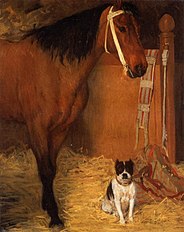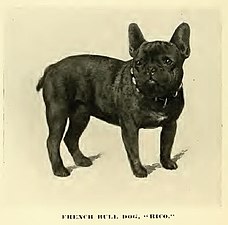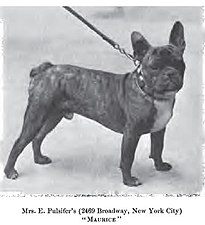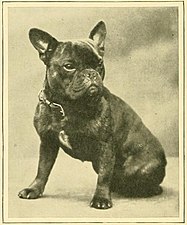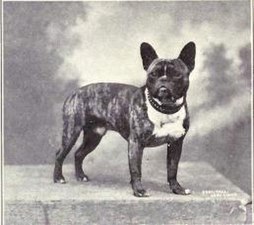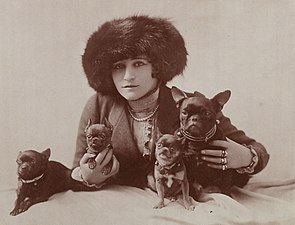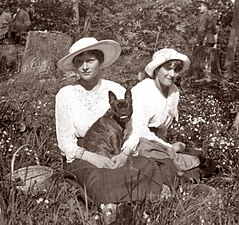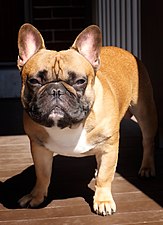French Bulldog
 From Wikipedia - Reading time: 16 min
From Wikipedia - Reading time: 16 min
The examples and perspective in this article deal primarily with the United States and do not represent a worldwide view of the subject. (November 2021) |
| French Bulldog | |||||||||||||||||
|---|---|---|---|---|---|---|---|---|---|---|---|---|---|---|---|---|---|
 | |||||||||||||||||
| Other names | Bouledogue Français | ||||||||||||||||
| Origin | France[1] | ||||||||||||||||
| |||||||||||||||||
| |||||||||||||||||
| Dog (domestic dog) | |||||||||||||||||
The French Bulldog (French: Bouledogue Français) is a French breed of companion dog or toy dog. It appeared in Paris in the mid-nineteenth century, apparently the result of cross-breeding of Toy Bulldogs imported from England and local Parisian ratters.[3] It is commonly kept as a pet and is among the most frequently registered dogs in a number of countries including Australia, the United Kingdom, and the United States. The breed is susceptible to various health problems as a consequence of being bred for a distinctive appearance, sporting a brachycephalic face and skin wrinkles.
History
[edit]From the beginning of the nineteenth century, bulldogs were bred in the United Kingdom for purposes other than traditional blood sports such as bull-baiting, which were banned in 1835.[4]: 5 By the middle of the century there were miniature bulldogs, most weighing around 7–11 kg (15–24 lb).[4]: 6
At the same time, lace workers from Nottingham who were displaced by the Industrial Revolution began to settle in Normandy, France.[5]: 58 They brought a variety of dogs with them, including Toy Bulldogs.[6] The dogs became popular in France and a trade in imported small Bulldogs was created, with breeders in England sending over Bulldogs that they considered to be too small, or with faults such as ears that stood up. By 1860, there were few Toy Bulldogs left in England, such was their popularity in France.[4]: 6
The small Bulldog type gradually became thought of as a breed, and received a name, the Bouledogue Francais.[4]: 6 This French version of the English name is also a contraction of the words boule ('ball') and dogue ('mastiff'). The dogs were highly fashionable and were sought after by society ladies and Parisian prostitutes alike, as well as creators such as artists, writers, and fashion designers.[4]: 6 The artists Edgar Degas and Henri de Toulouse-Lautrec are thought to have French Bulldogs in their paintings.[7] However, records were not kept of the breed's development as it diverged further away from its original Bulldog roots. As it changed, terrier stock had been brought in to develop traits such as the breed's long straight ears.[4]: 6
Depictions in nineteenth-century paintings
[edit]-
Toulouse-Lautrec: Bouboule, Bull-dog de madame Palmyre, à la souris, 1897
-
A l'écurie, cheval et chien, Edgar Degas, about 1861
-
Toulouse-Lautrec
-
Toulouse-Lautrec
Breed clubs and modern recognition
[edit]Americans had been importing French Bulldogs for a while, but it was not until 1885 that they were brought over in order to set up an American-based breeding program. They were mostly owned by society ladies, who first displayed them at the Westminster Kennel Club Dog Show in 1896.[8] In the following year, the judge at the dog show, George Raper, only chose winners with "rose ears"—ears that folded at the tip, as with the standard for Bulldogs.[9] The ladies formed the French Bull Dog Club of America and created a breed standard which preferred the "erect bat ear" type.[4]: 7 In the early 20th century, the breed remained in vogue for high society, with dogs changing hands for up to $3,000 and being owned by members of influential families such as the Rockefellers and the J. P. Morgans. The American Kennel Club recognized the breed quickly after the breed club was formed, and by 1906 the French Bulldog was the fifth most popular dog breed in America.[4]: 8
This new Bulldog breed arrived for the first time in England in 1893, with English Bulldog breeders in an uproar as the French imports did not meet the new breed standards in place by this time, and they wanted to prevent the English stock from crossbreeding with the French. The Kennel Club initially recognized them as a subset of the existing Bulldog breed rather than an entirely new breed.[4]: 6 Some English breeders in this period bred the French Bulldogs in order to resurrect the Toy Bulldog.[5]: 58 On 10 July 1902, at the house of Frederick W. Cousens, a meeting was held to set up a breed club in order to seek individual recognition for the French breed.[4]: 7 The adopted breed standard was the same one which was already in use in America, France, Germany and Austria.[5]: 58 Despite opposition from Miniature Bulldog (the new breed name for the Toy Bulldog) and Bulldog breeders,[5]: 59 in 1905, the Kennel Club changed its policy on the breed and recognized them separate from the English variety, initially as the Bouledogue Francais, then in 1912 as the French Bulldog.[4]: 7
Today the French Bulldog is commonly kept as a pet: in 2020, it was the second-most registered dog in the United Kingdom,[10] and the fourth-most in the United States.[11] They were rated the third-most popular dog in Australia in 2017.[12] In 2019, in the United Kingdom, the French Bulldog had a total of 33,661 registered dogs.[13] By comparison, the Labrador Retriever had over 36,700 dogs and the Cocker Spaniel fewer than 22,000. In 2013, the American Kennel Club (AKC) ranked the French Bulldog as the 10th most popular breed in the United States, enjoying a sharp rise in popularity from 54th place a decade before, in 2003.[14] In 2023, the French Bulldog overtook the Labrador as the most popular breed of dog as ranked by the AKC. Before 2023, Labradors had held the top spot for 31 years.[15]
Historic photographs
[edit]-
1890
-
1901, Maurice in New York City
-
1908, Anna Sacher
-
1911, Ch. Stanmore Argus
-
1915
-
between 1875 and 1917
-
1917 with Grand Duchesses Tatiana and Anastasia Nikolaevna of Russia
Description
[edit]The American Kennel Club standard for the French Bulldog states that it should be muscular, with a soft and loose coat forming wrinkles.[6]
The AKC Standard weight for a French Bulldog is at maximum 28 pounds (13 kg).[16] The head of a French bulldog should be square shaped and large, with ears that resemble bat ears.[16] French bulldogs are a flat-faced breed.[17] Eyes that are AKC Standard approved for French Bulldogs are dark, almost to the point of being black; blue eyed French bulldogs are not AKC approved.[16] The coat of a French bulldog should be short haired and fine and silky.[17] Acceptable colors under the breed standard are the various shades of brindle, fawn, cream or white with brindle patches (known as "pied"). The fawn colors can be any light through red.[16] The most common colors are brindle, then fawn, with pieds being less common than the other colors.[18] The breed clubs do not recognize any other colors or patterns.[16]
-
Brindle
-
Pied
-
Cream
-
Fawn
-
Black
-
Gray
Health
[edit]
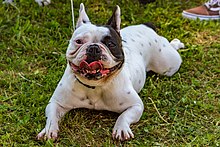
A study in the UK comparing French Bulldogs to the general canine population found that of 43 common conditions, the French Bulldog had significantly higher prevalence for almost half (20/43) and a significantly lower prevalence for a quarter (11/43). Stenotic nares had an occurrence rate of 42 times the general population, brachycephalic obstructive airway syndrome was 30 times more prevalent, aural discharge was 14 times more prevalent, skin fold dermatitis was 11 times more prevalent, and dystocia was 9 times more prevalent.[19]
In 2013, a UK Medical Study reviewed the health of 2228 French Bulldogs under veterinary care in the UK. The study found that 1612 (72.4%) of these French Bulldog had at least one recorded health issue: The most common disorders recorded were ear infections (14.0%), diarrhea (7.5%) and conjunctivitis (3.2%). Skin problems were the most commonly reported group of disorders (17.9%).[20]
Despite these challenges, the popularity of French Bulldogs continues to rise, emphasizing the importance of addressing their health issues.[21][22]
Brachycephaly
[edit]The shortened snout and pushed in face of the French Bulldog is known as brachycephaly.[23] Brachycephaly results in deformation of the upper airway tract and leads to obstruction of breathing.[24] Effects of brachycephaly are stridor, stertorous breathing, emesis, skin fold dermatitis, brachycephalic airway obstructive syndrome, exophthalmos, pharyngeal gag reflex, cyanosis, and laryngeal collapse.[25][26][27][28][29][30][31] Other issues arising from brachycephaly are risk of complications whilst under anaesthesia,[32] and hyperthermia — with the latter caused due to an inability to effectively reduce body temperature via panting.[33] French Bulldogs are banned by several commercial airlines due to the numbers that have died while in the air.[34][35]
Life expectancy
[edit]A study of the deaths of 30,563 dogs of different breeds in the United Kingdom in 2016–2020 found the French Bulldog to have a life expectancy at birth of 4.53 years, the lowest by a large margin of all breeds in the study, which found an average for all dogs of 11.23 years.[36]: 1 This same study indicates that the low life expectancy for French Bulldogs is possibly influenced by the increasing number of French Bulldogs present in the UK, increasing from 2,771 KC registered individuals in 2011 to 39,266 individuals in 2020, skewing the general population to be very young on average and biasing the data.[36]: 1 A Japanese study of pet cemetery data found the French Bulldog to have a life expectancy of 10.2 years, the lowest of all breeds in the study.[37][a] A 2024 UK study found a life expectancy of 9.8 years for the breed compared to an average of 12.7 for purebreeds and 12 for crossbreeds.[38]
Birth and reproduction
[edit]French Bulldogs frequently require Caesarean section to give birth, with over 80% of litters delivered this way.[39][40]
A UK study identified French Bulldog bitches to be 15.9 times more likely to experience dystocia.[41]
Orthopaedics
[edit]French Bulldogs are prone to having congenital hemivertebrae (also called "butterfly vertebrae"),[42][43] which will show on an X-ray.[44]
A review of more than 200,000 patients in the UK found that French Bulldogs had a noticeably higher occurrence of patellar luxation with the French Bulldog having an odds ratio of 5.4.[45]
Other conditions
[edit]A French study found that 45% of French Bulldogs presenting with a neurological condition had Hansen type I intervertebral disk herniation, with the study concluding that the French Bulldog is prone to the condition.[46]
A UK study found the French Bulldog to be more likely to suffer from thoracic vertebral malformations than other breeds.[47]
A British study found demodicosis to be more prevalent in the French Bulldog than other breeds. The overall prevalence in French Bulldogs was 1.3% compared to the overall rate of 0.17%. The prevalence in dogs under the age of 2 years was 1.9% compared to 0.48%.[48]
The French Bulldog is one of the most commonly affected breeds for hereditary cataracts.[49]
The French Bulldog is also prone to skin allergies (in addition to the demodicosis called out above) that often result in excessive licking of the paws, watery eyes, ear infections, sneezing, or vomiting.[50]
Notes
[edit]- ^ The Japanese study reviewed cemetery data which is unlikely to have any records of still-births and altricial deaths whilst a veterinary clinic likely would have some data on these.
References
[edit]- ^ "Bouledogue Français" [French Bulldog]. FCI breeds nomenclature (in French and English). Fédération Cynologique Internationale. 101. Retrieved 15 November 2021.
- ^ a b c d Bouledogue Français [French Bulldog] (PDF) (Report). FCI Standard (in French and English). Fédération Cynologique Internationale. N° 101 g09 / en. Retrieved 15 November 2021.
- ^ "Le bouledogue Français, Ses origines", 'Official breed club created in 1898 (fr)'
- ^ a b c d e f g h i j k Coile, D. Caroline (2005). French Bulldogs. Hauppauge, NY: Barron's. ISBN 9780764130311 – via Internet Archive (archive.org).
- ^ a b c d Robert, Leighton (1907). The New Book of the Dog. London, UK / New York, NY: Cassell – via Internet Archive (archive.org).
- ^ a b "Get to Know the French Bulldog", The American Kennel Club, retrieved 28 May 2014.
- ^ "French Bulldog Dog Breed Information". American Kennel Club. Retrieved 31 January 2020.
- ^ "A Sacramento heiress and [a] murder on the French bulldog express". Looking back. Sacramento News & Review. 4 February 2022. Archived from the original on 30 June 2022 – via sacramento.newsreview.com.
- ^ "History of the FBDCA". French Bull Dog Club of America. Retrieved 2 January 2019.
- ^ "Top Twenty Breeds In Registration Order For The Years 2018 And 2019" (PDF). The Kennel Club (UK). Archived from the original (PDF) on 26 June 2020. Retrieved 23 June 2020.
- ^ "AKC: Most Popular Dog Breeds of 2018". The American Kennel Club.
- ^ "Top 10 dog breeds in Australia 2017. Don't worry, they're all adorable". NewsComAu. Retrieved 12 April 2017.
- ^ "COMPARATIVE TABLES OF REGISTRATIONS FOR THE YEARS 2010 – 2019 INCLUSIVE" (PDF). The Kennel Club UK. Archived from the original (PDF) on 31 January 2020. Retrieved 18 May 2023.
- ^ American Kennel Club 2013 Dog Registration Statistics Historical Comparisons & Notable Trends, The American Kennel Club, Retrieved 28 May 2014
- ^ "Beloved and debated, French bulldog becomes top US dog breed". 15 March 2023. Retrieved 15 March 2023.
- ^ a b c d e Club, American Kennel. "American Kennel Club - Dog Breed Standards" (PDF).
- ^ a b "French Bulldog Dog Breed Information". American Kennel Club.
- ^ American Kennel Club (11 November 2014). The New Complete Dog Book: Official Breed Standards and All-New Profiles for 200 Breeds, 21st Edition. i5 Publishing. p. 912. ISBN 9781621870913.
- ^ O’Neill, Dan G.; Packer, Rowena M.A.; Francis, Peter; Church, David B.; Brodbelt, Dave C.; Pegram, Camilla (16 December 2021). "French Bulldogs differ to other dogs in the UK in propensity for many common disorders: a VetCompass study". Canine Medicine and Genetics. 8 (1): 13. doi:10.1186/s40575-021-00112-3. ISSN 2662-9380. PMC 8675495. PMID 34911586.
- ^ "Demography and disorders of the French Bulldog population under primary veterinary care in the UK in 2013" https://cgejournal.biomedcentral.com/articles/10.1186/s40575-018-0057-9#Sec4
- ^ O’Neill, Dan G.; Baral, Lauren; Church, David B.; Brodbelt, Dave C.; Packer, Rowena M. A. (3 May 2018). "Demography and disorders of the French Bulldog population under primary veterinary care in the UK in 2013". Canine Genetics and Epidemiology. 5 (1): 3. doi:10.1186/s40575-018-0057-9. ISSN 2052-6687. PMC 5932866. PMID 29750111.
- ^ Thompson, Dennis (20 December 2021). "Highly Inbred, French Bulldogs Face Higher Odds for 20 Health Issues". HealthDay. ProQuest 2611700588.
- ^ Knecht, C. D. (1979). Upper airway obstruction in brachycephalic dogs. Compend Contin Educ Pract Vet, 1, 25-31.
- ^ Hendricks, Joan C. (1992). "Brachycephalic Airway Syndrome". Veterinary Clinics of North America: Small Animal Practice. 22 (5). Elsevier BV: 1145–1153. doi:10.1016/s0195-5616(92)50306-0. ISSN 0195-5616. PMID 1523786.
- ^ TC, Amis; C, Kurpershoek (1986). "Pattern of breathing in brachycephalic dogs". American Journal of Veterinary Research. 47 (10). Am J Vet Res: 2200–2204. ISSN 0002-9645. PMID 3777646. Retrieved 6 February 2024.
- ^ Hendricks, J. C.; Kline, L. R.; Kovalski, R. J.; O'Brien, J. A.; Morrison, A. R.; Pack, A. I. (1 October 1987). "The English bulldog: a natural model of sleep-disordered breathing". Journal of Applied Physiology. 63 (4). American Physiological Society: 1344–1350. doi:10.1152/jappl.1987.63.4.1344. ISSN 8750-7587. PMID 3693167.
- ^ Hendricks, Joan C. (1992). "Brachycephalic Airway Syndrome". Veterinary Clinics of North America: Small Animal Practice. 22 (5). Elsevier BV: 1145–1153. doi:10.1016/s0195-5616(92)50306-0. ISSN 0195-5616. PMID 1523786.
- ^ Meola, Stacy D. (2013). "Brachycephalic Airway Syndrome". Topics in Companion Animal Medicine. 28 (3). Elsevier BV: 91–96. doi:10.1053/j.tcam.2013.06.004. ISSN 1938-9736. PMID 24182996.
- ^ Lundgrun, Becky (26 June 2006). "Reverse Sneezing (Pharyngeal Gag Reflex)". VeterinaryPartner.com. Retrieved 26 December 2009.
- ^ Sebbag, Lionel; Sanchez, Rick F. (2023). "The pandemic of ocular surface disease in brachycephalic dogs: The brachycephalic ocular syndrome". Veterinary Ophthalmology. 26 (S1): 31–46. doi:10.1111/vop.13054. ISSN 1463-5216. PMID 36585820.
- ^ Hobi, Stefan; Barrs, Vanessa R.; Bęczkowski, Paweł M. (16 June 2023). "Dermatological Problems of Brachycephalic Dogs". Animals. 13 (12). MDPI AG: 2016. doi:10.3390/ani13122016. ISSN 2076-2615. PMC 10294810. PMID 37370526.
- ^ Gruenheid, Michaela; Aarnes, Turi K.; McLoughlin, Mary A.; Simpson, Elaine M.; Mathys, Dimitria A.; Mollenkopf, Dixie F.; Wittum, Thomas E. (1 August 2018). "Risk of anesthesia-related complications in brachycephalic dogs". Journal of the American Veterinary Medical Association. 253 (3). American Veterinary Medical Association (AVMA): 301–306. doi:10.2460/javma.253.3.301. ISSN 0003-1488. PMID 30020004.
- ^ Ewers Clark, Anna (22 December 2022). "Heatstroke and brachycephalic dogs – is there an increased risk?". Veterinary Evidence. 7 (4). doi:10.18849/ve.v7i4.534. ISSN 2396-9776.
- ^ Haughney, Christine (6 October 2011). "Banned by Many Airlines, These Bulldogs Fly Private". New York Times. Retrieved 8 October 2011.
- ^ "Air Travel and Short-Nosed Dogs FAQ". American Veterinary Medical Association. Retrieved 7 July 2014.
- ^ a b Teng, Kendy Tzu-yun; Brodbelt, Dave C.; Pegram, Camilla; Church, David B.; O'Neill, Dan G. (2022). "Life tables of annual life expectancy and mortality for companion dogs in the United Kingdom" (PDF). Scientific Reports. 12 (2022): article 6415. Bibcode:2022NatSR..12.6415T. doi:10.1038/s41598-022-10341-6. PMC 9050668. PMID 35484374.
- ^ INOUE, Mai; KWAN, Nigel C. L.; SUGIURA, Katsuaki (2018). "Estimating the life expectancy of companion dogs in Japan using pet cemetery data". Journal of Veterinary Medical Science. 80 (7). Japanese Society of Veterinary Science: 1153–1158. doi:10.1292/jvms.17-0384. ISSN 0916-7250. PMC 6068313. PMID 29798968.
- ^ McMillan, Kirsten M.; Bielby, Jon; Williams, Carys L.; Upjohn, Melissa M.; Casey, Rachel A.; Christley, Robert M. (1 February 2024). "Longevity of companion dog breeds: those at risk from early death". Scientific Reports. 14 (1). Springer Science and Business Media LLC: 531. Bibcode:2024NatSR..14..531M. doi:10.1038/s41598-023-50458-w. ISSN 2045-2322. PMC 10834484. PMID 38302530.
- ^ Evans, Katy M.; Adams, Vicki J. (2010). "Proportion of litters of purebred dogs born by caesarean section". Journal of Small Animal Practice. 51 (2): 113–8. doi:10.1111/j.1748-5827.2009.00902.x. PMID 20136998.
- ^ Pete Wedderburn (6 April 2009). "Why do over 80 per cent of Bulldog births happen by caesarian section?". The Daily Telegraph. Archived from the original on 13 August 2011. Retrieved 5 August 2010.
- ^ Packer, Rowena. "New study reveals flat faced dogs have the highest risk when giving birth". Royal Veterinary College. University of London. Retrieved 13 March 2024.
- ^ "Hemivertebrae". Mar Vista Animal Medical Center. Archived from the original on 30 April 2015. Retrieved 21 December 2019.
- ^ "Genetic welfare problems of companion animals: Hemivertebrae". Universities Federation for Animal Welfare (UK). Archived from the original on 12 March 2015. Retrieved 21 December 2019.
- ^ "Hemivertebrae". Top Dog Animal Health. Retrieved 1 June 2015.
- ^ O’Neill, Dan G.; Meeson, Richard L.; Sheridan, Adam; Church, David B.; Brodbelt, Dave C. (2016). "The epidemiology of patellar luxation in dogs attending primary-care veterinary practices in England". Canine Genetics and Epidemiology. 3 (1): 4. doi:10.1186/s40575-016-0034-0. ISSN 2052-6687. PMC 4898461. PMID 27280025.
- ^ Mayousse, Vincent; Desquilbet, Loïc; Jeandel, Aurélien; Blot, Stéphane (5 July 2017). "Prevalence of neurological disorders in French bulldog: a retrospective study of 343 cases (2002–2016)". BMC Veterinary Research. 13 (1). Springer Science and Business Media LLC: 212. doi:10.1186/s12917-017-1132-2. ISSN 1746-6148. PMC 5497356. PMID 28676057.
- ^ Ryan, R.; Gutierrez-Quintana, R.; ter Haar, G.; De Decker, Steven (2017). "Prevalence of thoracic vertebral malformations in French bulldogs, Pugs and English bulldogs with and without associated neurological deficits" (PDF). The Veterinary Journal. 221. Elsevier BV: 25–29. doi:10.1016/j.tvjl.2017.01.018. ISSN 1090-0233. PMID 28283076.
- ^ O'Neill, D. G.; Turgoose, E.; Church, D. B.; Brodbelt, D. C.; Hendricks, A. (4 October 2019). "Juvenile-onset and adult-onset demodicosis in dogs in the UK: prevalence and breed associations". Journal of Small Animal Practice. 61 (1). Wiley: 32–41. doi:10.1111/jsap.13067. ISSN 0022-4510. PMC 7003809. PMID 31584708.
- ^ Oliver, James A.C.; Mellersh, Cathryn S. (2020). "Genetics". In Cooper, Barbara; Mullineaux, Elizabeth; Turner, Lynn (eds.). BSAVA Textbook of Veterinary Nursing (Sixth ed.). British Small Animal Veterinary Association. p. 131. ISBN 978-1-910-44339-2.
- ^ "The 10 Most Common French Bulldog Health Problems". Southern Cross Veterinary Clinic.
Other sources
[edit]- Lynch, Don (1992). Titanic: An illustrated history. New York, NY: Hyperion. ISBN 978-1-56282-918-6.
- French Bulldog (Report). Breed standards. London, UK: The Kennel Club. Retrieved 15 August 2022 – via thekennelclub.org.uk.
 KSF
KSF
